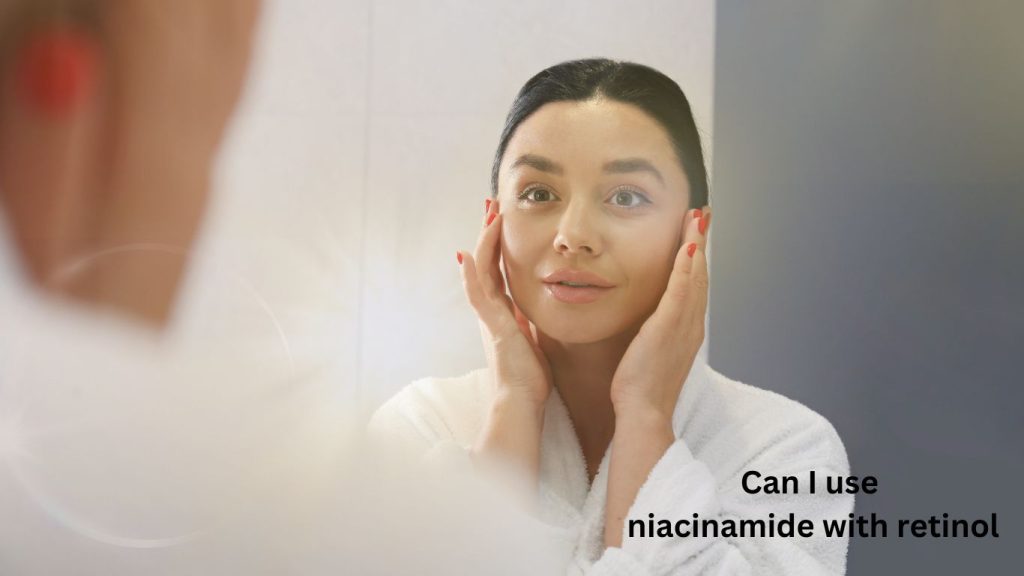Can I use niacinamide with retinol? The answer is yes. They work well together and can enhance each other’s benefits.
Niacinamide and retinol are popular skincare ingredients. They both offer significant benefits for improving skin health and appearance. Niacinamide, a form of vitamin B3, helps with inflammation, acne, and skin texture. Retinol, a vitamin A derivative, targets wrinkles, fine lines, and uneven skin tone.
Using them together can boost their effectiveness. Niacinamide can reduce retinol’s potential irritation, making it more tolerable. This combination is suitable for most skin types. Always introduce new products gradually and observe how your skin reacts. Consult a dermatologist if uncertain.

1. Understanding Niacinamide And Retinol
Combining niacinamide with retinol can enhance skin benefits, reducing irritation while boosting anti-aging effects. These two ingredients work harmoniously for a more youthful complexion.
Niacinamide and retinol are two powerhouse ingredients in skincare. Both offer unique benefits and, when combined, can work wonders for your skin. This section will help you understand how these ingredients function and why they can be a match made in heaven.
What Is Niacinamide?
Niacinamide, also known as vitamin B3, is a versatile skincare ingredient. It offers numerous benefits:
- Anti-inflammatory properties: Helps calm irritated skin.
- Reduces hyperpigmentation: Fades dark spots and uneven skin tone.
- Improves skin barrier: Strengthens the outer layer of the skin.
- Regulates oil production: Keeps skin balanced and reduces excess oil.
- Boosts hydration: Enhances moisture retention for a plump appearance.
What Is Retinol?
Retinol is a form of vitamin A known for its anti-aging benefits. This ingredient works wonders for skin rejuvenation:
Retinol stimulates cell turnover, encouraging new skin cells to replace old ones. This process reduces the appearance of fine lines and wrinkles. Additionally, it boosts collagen production, improving skin elasticity and firmness. Retinol is also effective in treating acne by unclogging pores and reducing inflammation.
Benefits Of Combining Niacinamide And Retinol
Using niacinamide and retinol together can enhance your skincare routine. Here’s why:
- Enhanced effectiveness: Niacinamide boosts the efficacy of retinol.
- Reduced irritation: Niacinamide soothes skin, minimizing retinol’s potential side effects.
- Comprehensive treatment: Addresses multiple skin concerns simultaneously.
- Balanced skin: Combines hydration with powerful anti-aging effects.
How To Incorporate Niacinamide And Retinol Into Your Routine
Wondering how to use these ingredients together? Here are some tips:
- Start slowly: Introduce one product at a time to gauge your skin’s reaction.
- Alternate nights: Use niacinamide one night and retinol the next.
- Layering: Apply niacinamide first, followed by retinol, to maximize benefits.
- Moisturize: Always follow with a good moisturizer to lock in hydration.
Potential Side Effects
While effective, using niacinamide and retinol together can cause side effects. Be mindful of:
Some users may experience dryness, redness, or peeling. To minimize these effects, start with lower concentrations and gradually increase. Always patch-test new products and consult with a dermatologist if any adverse reactions occur.
2. Benefits Of Combining Niacinamide And Retinol
Combining niacinamide with retinol can enhance skin texture and reduce irritation. This duo promotes a smoother, more even complexion.
Combining niacinamide and retinol can elevate your skincare routine to new heights. These two powerhouse ingredients offer a plethora of benefits when used together. Let’s delve into the notable advantages of this dynamic duo.
Enhanced Skin Barrier Function
Niacinamide strengthens the skin barrier, which is essential for healthy skin. This protective layer keeps moisture in and irritants out. Enhanced barrier function:
- Promotes hydration: Ensures skin stays moisturized and plump.
- Reduces sensitivity: Minimizes irritation often associated with retinol.
Improved Skin Texture
Together, niacinamide and retinol can dramatically improve skin texture. This combination targets multiple skin concerns, providing a smoother, more refined appearance.
Reduced Signs Of Aging
Retinol is well-known for its anti-aging properties, but pairing it with niacinamide can amplify these effects. This powerful duo works wonders in reducing fine lines and wrinkles.
- Stimulates collagen production: Retinol boosts collagen, enhancing skin firmness.
- Fades age spots: Niacinamide lightens dark spots and evens skin tone.
Minimized Pore Appearance
Many people are concerned about large pores. The combination of niacinamide and retinol can help minimize their appearance.
- Regulates oil production: Niacinamide balances oil levels, reducing pore size.
- Promotes cell turnover: Retinol encourages new cell growth, refining skin texture.
Enhanced Brightness And Radiance
The blend of these ingredients can greatly benefit dull skin. They work synergistically to improve overall skin brightness and radiance.
Using niacinamide with retinol can significantly enhance your skincare results. This combination addresses multiple skin concerns, making your skin look healthier and more youthful.
3. How To Use Niacinamide And Retinol Together Safely
Niacinamide and retinol can be used together for enhanced skincare benefits. Start with low concentrations and apply niacinamide first. After a few minutes, follow up with retinol to minimize irritation.
Combining niacinamide and retinol can significantly enhance your skincare routine. These powerful ingredients work synergistically to improve skin texture, reduce fine lines, and combat hyperpigmentation. Understanding how to use them together safely ensures you reap the maximum benefits without irritation.
Patch Test First
It’s crucial to perform a patch test before integrating any new products into your skincare regimen:
- Apply a small amount of each product: Test on your inner forearm or behind your ear.
- Wait 24 hours: Check for any adverse reactions like redness, itching, or swelling.
- Proceed if no irritation occurs: You can safely use niacinamide and retinol together.
Start Slowly
Introduce niacinamide and retinol gradually to allow your skin to adjust:
- Use niacinamide daily: Start with a lower concentration and increase as tolerated.
- Apply retinol every other night: Begin with a low strength and slowly increase frequency.
Layering Order
Proper layering ensures optimal absorption and minimizes irritation:
- Cleanse your face: Remove makeup and impurities.
- Apply niacinamide: Use it after cleansing and toning.
- Wait for absorption: Give it a minute to sink in.
- Follow with retinol: Apply a pea-sized amount of retinol.
Hydrate And Moisturize
Hydration is key to preventing dryness and irritation:
- Use a hydrating serum: Apply a hyaluronic acid serum before niacinamide.
- Moisturize well: Lock in moisture with a good quality moisturizer.
Sun Protection
Both niacinamide and retinol can make your skin more sensitive to the sun:
- Apply sunscreen daily: Use a broad-spectrum SPF 30 or higher.
- Avoid sun exposure: Wear protective clothing and hats.
By following these steps, you can safely integrate niacinamide and retinol into your skincare routine, achieving healthier, more radiant skin.
4. Niacinamide And Retinol: Potential Side Effects And How To Avoid Them
Combining niacinamide with retinol can yield impressive skin benefits, but potential side effects like irritation may occur. Gradually introduce them into your routine to avoid issues and ensure proper hydration.
Niacinamide and retinol can offer numerous skin benefits. However, some people may experience side effects. Understanding and avoiding these potential issues is crucial for a safe skincare routine.
Common Side Effects
Some users might encounter side effects when combining niacinamide and retinol. These can include:
- Redness: Skin may turn red, indicating irritation.
- Peeling: Skin might peel as it adjusts to the products.
- Dryness: Retinol can dry out the skin, leading to flakiness.
- Sensitivity: Increased sensitivity to sunlight is possible.
How To Minimize Side Effects
To reduce the likelihood of side effects, follow these tips:
- Start Slowly: Begin with a lower concentration of retinol and niacinamide.
- Use Moisturizer: A good moisturizer can help combat dryness and peeling.
- Apply Sunscreen: Protect your skin with a broad-spectrum SPF during the day.
- Alternate Days: Use niacinamide and retinol on different days to let your skin adapt.
Ideal Application Techniques
Proper application can make a big difference. Here’s how to do it right:
- Cleanse First: Ensure your face is clean before applying any products.
- Use Niacinamide First: Apply niacinamide before retinol for better absorption.
- Wait Between Layers: Allow each product to absorb fully before applying the next.
Recognizing And Addressing Allergic Reactions
It’s essential to recognize signs of an allergic reaction. Watch for these symptoms:
- Severe Itching: Unusual itching may indicate an allergy.
- Swelling: Swelling around the eyes or mouth is a red flag.
- Rash: A rash that spreads quickly needs attention.
If you notice any of these signs, discontinue use immediately and consult a dermatologist.
5. Best Skincare Routine Incorporating Niacinamide And Retinol
Niacinamide and retinol can be used together for a potent skincare routine. Combine these ingredients to enhance skin texture, reduce fine lines, and brighten complexion.
Achieving flawless skin often involves understanding how different ingredients work together. Niacinamide and retinol are two powerhouse ingredients. Combining them can optimize your skincare routine for radiant, youthful skin.
Step 1: Cleanse Your Face
Start with a gentle cleanser to remove dirt and oil. This prepares your skin to absorb active ingredients.
- Choose a mild cleanser: Ensures skin isn’t stripped of natural oils.
- Use lukewarm water: Opens pores for deeper cleansing.
- Pat dry: Avoid rubbing to prevent irritation.
Step 2: Apply Niacinamide Serum
Niacinamide is usually applied after cleansing. This ingredient helps to calm and hydrate the skin.
Niacinamide reduces inflammation and regulates oil production. It can also minimize the appearance of pores.
Step 3: Moisturize
Hydrate your skin to maintain its barrier. This step is crucial before applying retinol to prevent dryness.
- Opt for a non-comedogenic moisturizer: Prevents clogged pores.
- Look for ingredients like hyaluronic acid, Which boosts hydration.
- Apply evenly: Ensures all areas are moisturized.
Step 4: Use Retinol
Retinol should be applied after your skin is hydrated. It boosts cell turnover and fights signs of aging.
Retinol can initially cause irritation. Start with a lower concentration, then gradually increase.
Step 5: Finish With Sunscreen
Sunscreen is essential in any skincare routine, especially when using retinol. Protects your skin from harmful UV rays.
- Choose SPF 30 or higher: Provides adequate protection.
- Apply generously: Ensures full coverage.
- Reapply every two hours: Maintains protection throughout the day.
Incorporating niacinamide and retinol into your routine can yield impressive results. Just follow these steps for a balanced and effective regimen.
Click Here to Buy Niacinamide And Retinol.
6. Who Should Avoid Using Niacinamide And Retinol Together?
Individuals with sensitive skin or specific skin conditions should avoid using niacinamide and retinol together. Combining these ingredients may lead to irritation and redness.
Combining niacinamide and retinol can be a game-changer for many skincare routines. However, not everyone should use these two powerful ingredients. Let’s explore who might need to avoid this combination.
Sensitive Skin Types
People with sensitive skin should exercise caution.
- Easily irritated skin: Niacinamide and retinol can cause redness and irritation.
- Prone to allergic reactions: These ingredients might trigger allergic responses.
Pregnant And Nursing Women
It’s generally advised for pregnant and nursing women to avoid retinol.
Retinoids can impact fetal development, so it’s best to consult a doctor before use.
Individuals With Rosacea
Rosacea sufferers might experience flare-ups.
- Increased redness: Retinol can exacerbate rosacea symptoms.
- Skin sensitivity: Niacinamide can also irritate already sensitive skin.
Those Using Other Active Ingredients
Mixing too many activities can overwhelm the skin.
- Multiple actives: Using many actives can lead to irritation.
- Layering issues: Incorrect layering might reduce effectiveness.
Beginners In Skincare
Skincare novices should introduce one active ingredient at a time.
Introducing both together: May cause excessive dryness and irritation.
People With Compromised Skin Barriers
A compromised skin barrier needs gentle care.
- Barrier repair: Focus on barrier-repairing products first.
- Avoiding strong actives: Strengthen the skin before introducing potent ingredients.

7. Niacinamide With Retinol: Expert Opinions And Dermatologists’ Recommendations
Experts and dermatologists affirm that niacinamide and retinol can be used together, offering enhanced skin benefits. This combination effectively reduces wrinkles and improves skin texture.
Combining niacinamide and retinol in your skincare routine has sparked significant interest. Many wonder if these two powerhouse ingredients can be used together. Let’s delve into expert opinions and dermatologists’ recommendations on this topic. Google Maps.
Expert Opinions On Niacinamide And Retinol
Experts often provide valuable insights into skincare practices. Here’s what they say about using niacinamide and retinol together:
- Niacinamide’s Benefits: It calms inflammation, reduces redness, and improves skin texture.
- Retinol’s Role: It boosts collagen production, reduces fine lines, and addresses pigmentation.
- Combined Effect: Both can produce a more balanced skin tone and enhanced overall health.
Dermatologists’ Recommendations
Dermatologists often weigh in on the best practices for combining skincare ingredients. Here are their top recommendations:
- Start Slowly: Introduce one product at a time to see how your skin reacts.
- Use Separately: Apply niacinamide in the morning and retinol at night.
- Layering Tips: If you use both at night, apply niacinamide first, let it absorb, then apply retinol.
- Patch Test: Always perform a patch test before adding new products to your routine.
- Moisturize: Follow up with a good moisturizer to prevent dryness and irritation.
Benefits Of Combining Niacinamide And Retinol
Many skincare enthusiasts find that combining niacinamide and retinol offers numerous benefits:
- Enhanced Hydration: Niacinamide helps retain moisture, reducing retinol-induced dryness.
- Improved Skin Barrier: Niacinamide strengthens the skin barrier, making it more resilient.
- Reduced Irritation: Niacinamide’s anti-inflammatory properties can soothe retinol-induced irritation.
Potential Concerns And How To Address Them
While combining these ingredients can be beneficial, some concerns need addressing:
- Irritation Risk: Retinol can cause irritation, especially for sensitive skin.
- Gradual Start with lower concentrations and increase gradually.
- Use Sunscreen: Both ingredients can make skin more sensitive to UV rays, so always use sunscreen during the day.
How To Incorporate Both In Your Routine
Wondering how to add both niacinamide and retinol to your routine? Here’s a simple guide:
- Alternate Days: Use niacinamide one day and retinol the next.
- Layering: Apply niacinamide first, then retinol, to maximize benefits.
- Consistency: Stick to a consistent routine for the best results.
Real-life User Experiences
Many users have shared their experiences with combining niacinamide and retinol:
- Positive Feedback: Most users report improved skin texture and reduced fine lines.
- Adaptation Period: Some experienced initial irritation but found it subsided with continued use.
- Personalized Approaches: Users often tailor their routines to their skin’s needs, highlighting the importance of listening to your skin.
Combining niacinamide and retinol can be a game-changer for your skincare routine. By following expert advice and dermatologist recommendations, you can achieve healthier, more radiant skin.
Frequently Asked Questions
Can I Use Niacinamide With Retinol Together?
Yes, you can use niacinamide with retinol. They complement each other well. Niacinamide soothes the skin and reduces irritation. Retinol boosts cell turnover and fights aging. Together, they improve skin texture and tone.
Should I Apply Niacinamide Before Retinol?
Yes, apply niacinamide before retinol. Niacinamide prepares the skin and reduces irritation. Wait for niacinamide to absorb fully before applying retinol. This sequence maximizes the benefits of both ingredients.
What Are The Benefits Of Niacinamide And Retinol?
Niacinamide reduces redness and strengthens the skin barrier. Retinol boosts collagen and reduces fine lines. Together, they improve skin texture, tone, and overall appearance.
Can Niacinamide Reduce Retinol Irritation?
Yes, niacinamide can reduce retinol irritation. It strengthens the skin barrier and soothes inflammation. This makes retinol more tolerable, especially for sensitive skin.
Conclusion
Combining niacinamide and retinol can enhance your skincare routine. Both ingredients offer significant benefits. Ensure you start slowly to avoid irritation. Consult a dermatologist for personalized advice. Incorporate these powerful ingredients to achieve healthier, radiant skin. Your complexion will thank you for your thoughtful care and attention.

